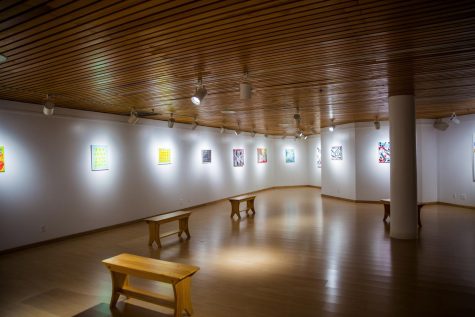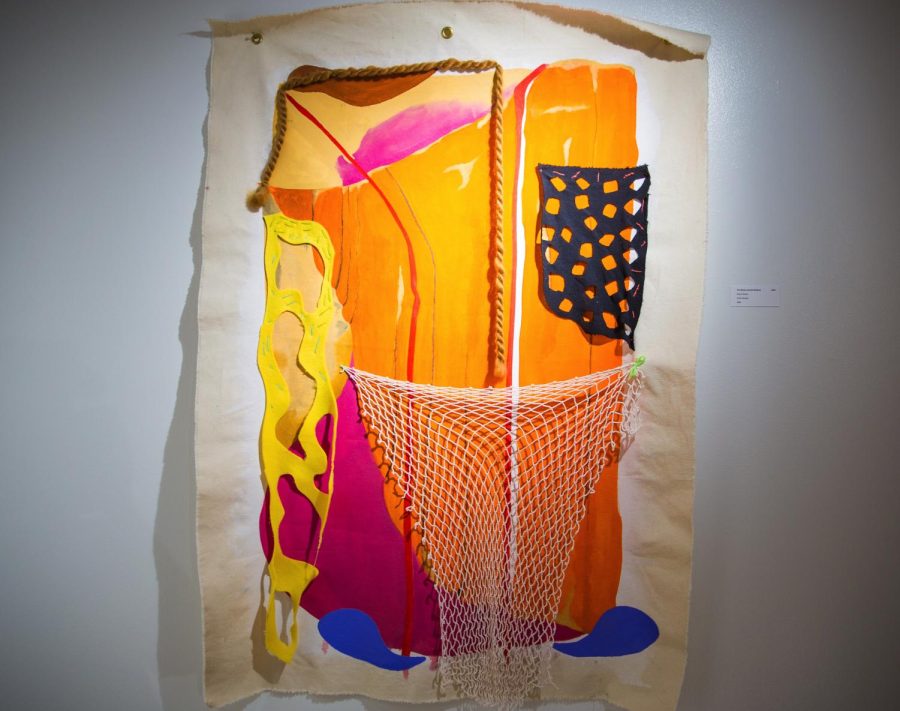Collaging is synonymous with magazines and glue — the elementary school project that had you digging in the trash to find last week’s newspaper.
At “Stratified Silhouettes,” collaging has grown up. The abstract exhibit by four local artists in the St. Paul Student Center’s Larson Gallery presents a collection of layered compositions and is on display now until April 29.
Holly Kilander, a recent University alumna, is an environmentalist who came to the University to supplement her art curriculum with environmental classes. Recently, her art has been about “bringing the outside in,” she said.
“The Waste and the Method,” one of her pieces on display at Larson, explores landscapes through mixed media. She began the construction with aerial photos as reference, blocked out the form and then began choosing conflicting colors to put next to each other. “It’s grotesque in a sort of juicy way; it looks good, but something’s kind of weird about it,” she said about the colors. As the most traditional collage on display, the piece uses fabric, paint, netting and string on unstretched canvas.
Emily Quandahl, an avid classical violist and Minneapolis-based artist, has a degree in music, but one day decided music wasn’t for her and transitioned to visual arts. She admits the decision was less romantic than it sounds but carries a romantic spirit in her work. “I romanticize the world and simplify it down to colors in shapes,” Quandahl said.
Combining hard lines, fluid washes and traces of spray paint, Quandahl’s paintings are a dense collage of layered techniques with anywhere from 10 to 50 layers per piece. The layers don’t stop until she’s content, and if the piece isn’t quite working, she’ll add a couple layers of wash and start over.
With a visual medium, “I can say what I want to say without having to say anything. I never felt I had the ability to do that with music,” Quandahl said.
Igor Dukic, a Minneapolis graphic designer, sees music and art interchangeably: “Art is like making music: like layering of symphonies and different instruments,” Dukic said.
For his piece “Becoming Nobody,” inspiration came from 10 years of meditation experience and a meditative state he’s recently been falling into:
“I was nobody but I was one with everything, there was this oneness. On an atomic level, this energy can sink in the ecstasy of love. Everything would be illuminated, and my body would be the same as everything else,” Dukic said. “It would be this energy emanating and making all these forms.”
The piece depicts the silhouette of a face dissolving into a collection of colored blobs which Dukic refers to as the universal consciousness.
For Dukic, life is about finding who you are, and art comes from the subconscious.
Taking a deep dive into one’s self for inspiration was crucial to finding creative identity for aspiring tattoo artist Alexander Pollock.
When tough times hit Pollock, living out of his car and couch-hopping become a reality. At that point, “there were lots of opportunities for me to become a different person, but instead I focused on who I truly am — whether or not my environment was telling me to be that way,” Dukic said. Finding creativity and inspiration within himself allowed Pollock to be his own muse and get past artist’s block.
He began painting canvases out of his car, making use of an abstract and unconscious style. What started as collages of color, splatters and textures, later incorporated graffiti-style calligraphy to give Pollack’s art its signature contrast.

Want to try your hand at collaging the pieces together? Head to the gallery on April 15 at 5 p.m. for a jigsaw competition with puzzles based on the artists’ works.
“I like to think of collaging as real-life Photoshop,” Quandahl said. “It allows my brain to think — I can make another piece to this puzzle that looks completely different to the piece next to it, but it still works together.”














